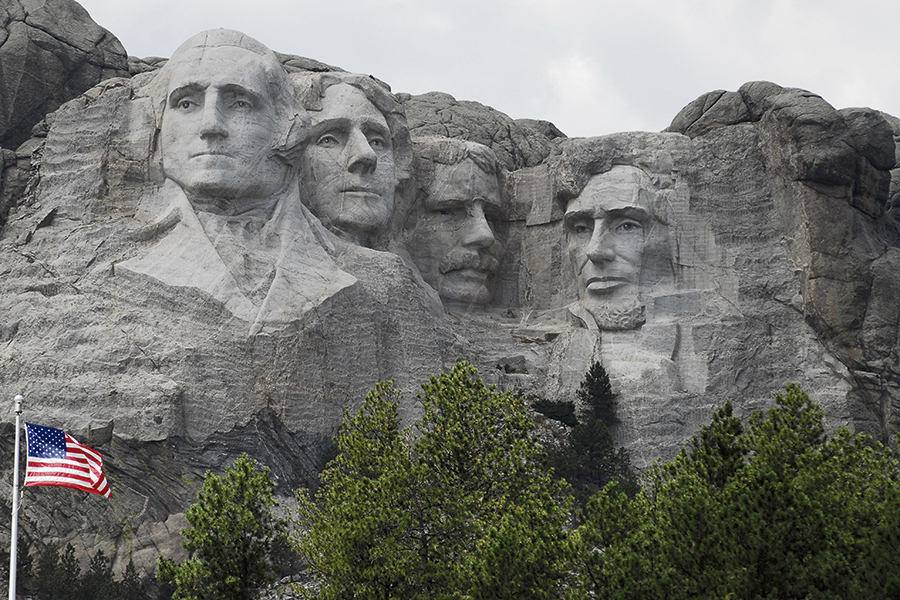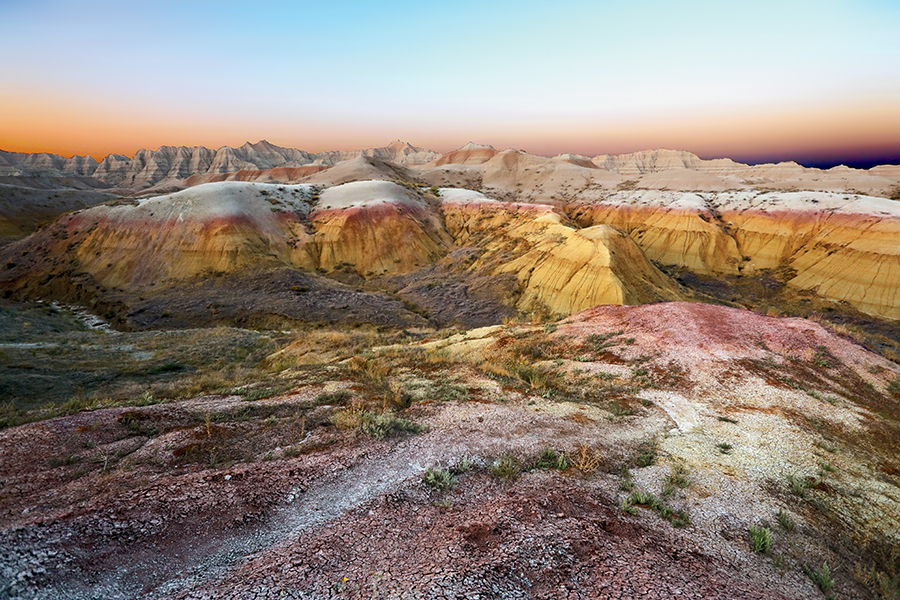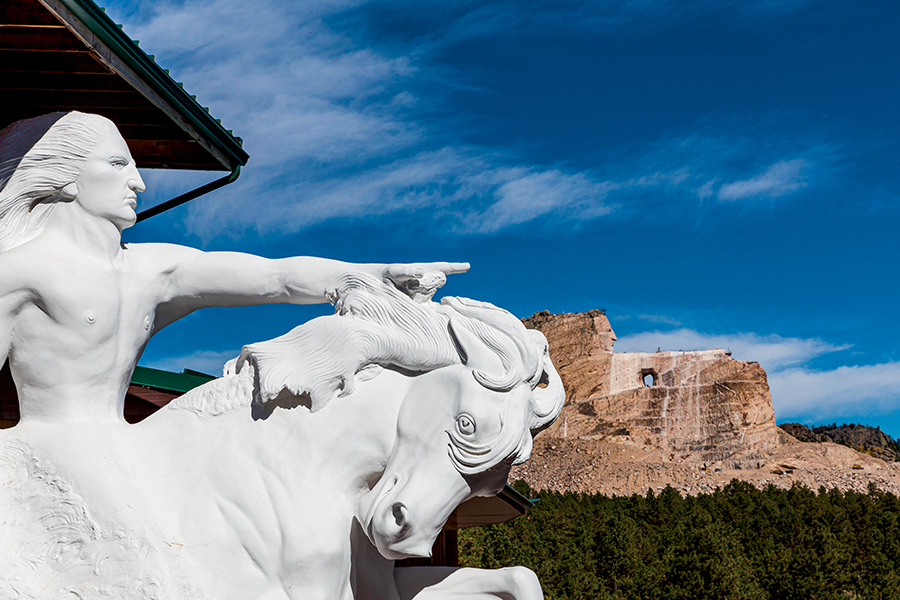Black Hills, Badlands, and Buffalo Jams

A herd of bison flanks the road at Custer State Park in South Dakota. © Dreamstime.com/Alexander Cimbal
Editor’s Note: As COVID-19 travel restrictions continue to evolve, please call ahead to confirm the status and hours of any place you plan to visit. EnCompass’ articles are only intended to inform its readers of the available options when traveling. We encourage readers to be mindful of all state and local orders related to COVID-19 safety guidelines and protocols.
As a professional travel writer for more than 30 years, I haven’t been many places where the wonders of nature have overwhelmed me. One such place that wildly surpassed my expectations is only about six hours from Denver—southwestern South Dakota.
This region is so much more than the definitively iconic Mount Rushmore. It’s home to a seemingly endless list of natural and man-made attractions, many within the gorgeously lush, vast Black Hills National Forest, which stret ches more than 1.25 million acres, spanning most of southwestern South Dakota and into eastern Wyoming.
Winds of nature
As my husband and I left Colorado, crossing north through Wyoming, and entering South Dakota via Route 16, we soon saw small groups of slender pronghorn in the distance, running and jumping in their awesomely agile way. As we arrived at our first stop, Wind Cave National Park, we were greeted by a small herd of huge woolly bison surrounding both sides of the road, and even crossing between the stopped cars. Heeding the warning signs not to lean out from the car to take photos, I simply rolled down the window and was delighted to breathe the distinct sweet fragrance of the clover and grasses.
The Wind Cave’s draw is below ground, where a limestone maze of 147 miles of known passageways exists. This mind-boggling labyrinth is a wonderland of rare and mystical crystal formations, called gypsum beard and boxwork, as well as white calcite crystals. It’s a sacred place for the Oglala Lakota people, and you might see some of their colorful prayer cloth pieces draped at the opening or other spots throughout the cave.
Eye of the needle
Our next stop was Custer State Park, where nearly 1,300 bison, along with pronghorn, elk, mountain goats, and burros roam, in one of the nation’s largest state parks. This magnificent area repeatedly astonished us as we hiked through the area with the extraordinary lushness of its meadows and valleys, coupled with the unique towering granite formations akin to slender pinnacles. The rocks glitter in the sunlight due to the quartz, feldspar, and mica in their makeup—it was like walking on diamonds! The towering Ponderosa pines are so dense they lend to the moniker of the “black” hills, along with huge stands of sun-dappled aspen, both with ferns, grasses, and wildflowers at their bases. The many abandoned farmhouses and barns, with their weathered wood and rusted machinery, are both haunting and beautiful.
Custer State Park is famed for its scenic Needles Highway, with its wooden pigtail bridges and six one-lane tunnels, which are so narrow larger vehicles cannot pass through. Each direction takes turns and honks in warning as they exit. I got a bit of shivers every time we entered and a sigh of relief when we safely drove out. Another nail-biter was the Needles Eye Tunnel, aptly named for the rock formation above it. It’s an ideal spot for a few photo ops.
The Fab Four

The carved faces of George Washington, Thomas Jefferson, Theodore Roosevelt, and Abraham Lincoln on Mount Rushmore in South Dakota. © Dreamtime.com/Cia Pix
A visit to Mount Rushmore is one of the main draws to this part of South Dakota, and we found coming in the late afternoon time was ideal. It wasn’t crowded at all, and it was cool enough to hike the Nature Trail to the prime viewing points. The 60-foot faces of George Washington, Thomas Jefferson, Theodore Roosevelt, and Abraham Lincoln are truly compelling. The park rangers and the visitors center offer plenty of information about the 14-year-old process of building the site. This was definitely an educational experience.
After our visit to Mount Rushmore, we headed to Rapid City where we were greeted by the City of Presidents, a series of life-size bronze statues of past U.S. presidents situated along the city’s streets and sidewalks. The charming downtown area offers plenty of shopping, dining, and attractions, including one of our favorites: Prairie Edge Trading Company. This shop is two stories tall and two blocks wide, and houses a collection of exquisite Native American art, crafts, jewelry, and relics, as well as a fascinating collection of Italian glass beads. I recommend staying at the historic AAA Three Diamond-designated Hotel Alex Johnson. Built in 1928 with handcrafted décor and Germanic Tudor architecture, this luxury boutique hotel takes you back in time while immersing you in modern comforts, and its rooftop Sky Bar is perfect for imbibing and perusing the view.
A splendid palette

Badlands National Park’s distinct landscape of striped rock formations painted in grays, pinks, creams, and browns. © Ted Alan Stedman
The next morning, we set off to the renowned Badlands National Park. Just an hour from Rapid City, it’s the only national park for which a large section is co-managed by a Native American tribe—the Oglala Sioux Lakota. This fantastic, windswept region stole my heart. Its desolate, yet staggering beauty brought me an immense feeling of joy and tranquility. Almost immediately, I started to plan another visit to experience it at sunrise and sunset.
As we entered the park, “Beware of Bison” signs began appearing everywhere. We couldn’t resist stopping at just about every pullout to view the bison. First one solitary bull appeared, then a few moments later, another. As we continued along, rather suddenly, we knew we were truly in the Badlands when the moon-like landscape of incredible striped rock formations, painted in grays, pinks, creams, and browns, spread out before us.
This splendid palette of cliffs, scalloped buttes, and rounded gray mounds in every shape imaginable, looked like an elephant’s backside, with small grassy outcroppings and gullies in between. It was lonely, yet so beautiful, and as we drove the Badlands Scenic Loop Byway, we enjoyed meeting folks from all over the world at the viewpoints.

Crazy Horse is the world's largest mountain carving located in the Black Hills of South Dakota. © Alamy/Sherry Talbot
Before heading back home to Colorado, we wanted to visit one last Native American landmark, the Crazy Horse Memorial. In 1939, Chief Henry Standing Bear asked sculptor Korczak Ziolkowski to create a memorial that would show “the red man has great heroes, also.” In 1948, Ziolkowski began carving the great Oglala Lakota warrior into Thunderhead Mountain. Unfortunately, Ziolkowski died in 1982, before he could complete the project. His wife, Ruth (now deceased), several of his children and grandchildren, and members of the Crazy Horse Mountain Crew, to this day, are committed to complete Ziolkowski’s and Chief Standing Bear’s legacy. When completed, Crazy Horse, sitting upon his steed, will stand 563 feet high and 641 feet long. Located 17 miles from Mount Rushmore, it’s well worth a visit to see the excellent film depicting the complex process of sculpting the mountain, and to tour the cultural center and museums, with exhibits of Native American art, relics, and information about many different tribes throughout the Americas.
Leaving South Dakota, we chuckled to each other as we saw a sign promoting Custer State Park. “May you get caught up in many buffalo jams,” it said. And you will, when you venture to the stunning wilderness of South Dakota’s southwestern corner. Just stay in your car, roll down the windows, and breathe.





